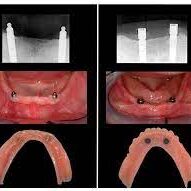Implant supported overdentures is a type of removable denture connected to dental
implants. The implants are fitted with a special mechanism that clicks with the dentures to
lock them securely. It is different from traditional dentures, which sit directly on the gum
tissues.
Implant Overdentures
Treatment
About This Treatment

The Process
Implant-supported overdentures are a type of removable
denture that is supported and anchored by dental implants.
This solution is often recommended for individuals who have
lost all their teeth in an arch but want a more stable and secure
option than traditional dentures. Here’s a broad overview of the
procedure for placing implant-supported overdentures:
Consultation and Assessment
- Dental Evaluation:
- Comprehensive oral examination and evaluation of oral and overall health.
- Imaging:
- Acquiring X-rays or CT scans to assess jawbone quality and quantity.
- Treatment Planning:
- Discussing treatment options, outcomes, and creating a personalized treatment plan.
Pre-Implant Preparations
- Tooth Extractions:
- If necessary, removing any remaining teeth.
- Bone Grafting:
- If needed, performing bone grafting to ensure sufficient bone volume.
Dental Implant Placement
- Surgical Procedure:
- Placing dental implants in the jawbone under local anesthesia. Typically, 2-4 implants are placed in each arch.
- Healing Cap Placement:
- Securing healing caps to protect the implant sites and shape the gum tissue.
Healing and Osseointegration
- Recovery:
- Allowing several weeks to months for the bone to integrate securely with the implants (osseointegration).
- Temporary Denture:
- Wearing a temporary denture if necessary to avoid any aesthetic concerns.
Creating and Fitting the Overdenture
- Impression:
- Taking precise impressions or digital scans of the jaw and implants.
- Fabrication:
- Constructing the overdenture in a dental lab based on the impressions and dentist’s specifications.
- Fitting and Adjustments:
- Trying in the overdenture, ensuring proper fit, comfort, and bite, making adjustments as necessary.
Attaching the Overdenture
- Attachment Pieces:
- Fitting attachment pieces to the implants, which will hold the overdenture securely in place.
- Overdenture Placement:
- Placing the overdenture so that it “snaps” onto or connects securely to the attachment pieces on the implants.
Post-Placement Care and Follow-Up
- Care Instructions:
- Providing detailed instructions for cleaning and caring for the overdenture and oral tissues.
- Follow-Up Visits:
- Monitoring the function and health of the implant-supported overdenture and surrounding tissues.
Before and After
SEE OUR RESULTS
Patient Stories
The Dental Implant Institute has been an excellent dentist surgery that I have been attending as a patient for many years. When I was young I didn’t have a pleasant experience with my local dentist on more than one occasion. I found the dentist at The Dental Implant Institute very reassuring and comforting. The management…
A great surgery; Dr Javier in particular spent time with me to make sure my new night guards fitted well and were up to the job
I lost my two front teeth whilst at school and had complications for years. Unfortunately I ended up needing an implant – which I had been avoiding! I wish I had done it sooner. Dr Javier was fantastic and guided me through each stage. He was always contactable to answer any queries or concerns. Very…
FAQs
What is the difference between all on 4 and implant overdenture?
The biggest difference between an All-on-Four appliance and an overdenture is the way that it’s shaped. As a permanent appliance, you never have to take it out. Plus, All-on- Four treatments don’t cover the roof of your mouth.
How do implant overdentures differentiate themselves from conventional dentures in terms of structure and functionality?
Implant overdentures amalgamate the conventional prosthesis design with implant technology, establishing a symbiosis that aims to enhance stability, retention, and functional efficacy. Unlike conventional dentures, which rely predominantly on mucosal support and inherent anatomical contours for stability, implant overdentures utilize strategically placed dental implants as pillars of support and retention. This integration not only alleviates some of the functional limitations intrinsic to conventional dentures, such as diminished masticatory efficiency and potential mobility, but also provides a platform that potentially mitigates the resorptive patterns associated with edentulism, thereby navigating a pathway that intertwines prosthetic functionality with biological and anatomical preservation.
What is the difference between implant supported dentures and overdentures?
Implant dentures or fixed dentures are similar to implant overdentures. Both provide a prosthetic crown as well as artificial gum tissue. However, the key difference is that this type of denture can not be removed by the individual at home.
What criteria are considered when determining the appropriateness of implant overdentures for a patient?
The decision to integrate implant overdentures into a patient’s restorative journey hinges upon a melange of criteria, including anatomical, biomechanical, physiological, and psychosocial dimensions. Anatomical considerations embrace bone quantity and quality, ensuring viable implant placement. Biomechanically, the ability of the proposed implant sites to accommodate occlusal loads is scrutinized. Physiologically, the patient’s systemic health and its potential impact on osseointegration and overall treatment success is evaluated. Psychosocially, the patient’s expectations, lifestyle, and willingness to adapt to the prosthetic modality form part of the comprehensive evaluation matrix that informs the appropriateness of implant overdentures within the specific clinical context.
Can implant overdentures be utilized in both maxillary and mandibular edentulous scenarios, and how do the approaches differ?
Implant overdentures indeed find application in both maxillary and mandibular edentulous scenarios, each presenting unique challenges and considerations. Mandibular implant overdentures, often supported by two implants (the so-called two-implant overdenture), have emerged as a well-documented and efficacious solution, mitigating some of the functional challenges associated with complete mandibular dentures. In contrast, maxillary implant overdentures might necessitate a greater number of implants, often in conjunction with specific design modifications, to accommodate the anatomical and biomechanical intricacies of the maxillary arch, such as sinus anatomy and varied bone density, thereby harmonizing prosthetic function with underlying anatomical landscapes.
What are the potential complications and maintenance considerations associated with implant overdentures?
Implant overdentures, while potent in mitigating edentulous challenges, are not devoid of potential complications and necessitate a diligent maintenance protocol. Complications can range from mechanical (such as fracture of the prosthesis or loss of retention) to biological (including peri-implantitis or mucosal inflammation). Maintenance considerations embrace routine evaluations to ensure optimal functionality, hygiene protocols tailored to navigate through the implant components, and periodic replacement of prosthetic elements such as retention clips or o-rings, ensuring that the biomechanical and biological harmony that underpins the success of implant overdentures is preserved through time.
What is the role of digital technology in the planning, execution, and maintenance of implant overdentures?
Digital technology carves out a pivotal role in the holistic management of implant overdentures, permeating through planning, execution, and maintenance phases. Digital imaging and virtual planning platforms enable precise implant positioning, ensuring optimal biomechanical distribution and prosthetic harmony. CAD/CAM technologies facilitate the fabrication of surgical guides and the prosthetic components, enhancing accuracy and predictability. Furthermore, digital technologies potentially streamline maintenance and management of complications, such as facilitating the rapid fabrication of replacement components or enabling virtual consultations to manage and triage issues, thereby interweaving digital precision with clinical acumen throughout the implant overdenture journey.
How do implant overdentures impact phonetics and aesthetics in edentulous individuals?
Implant overdentures can sculpt a notable impact on the phonetic and aesthetic dimensions of edentulous individuals. Phonetically, the enhanced stability and retention afforded by the implant support potentially alleviate some of the challenges often encountered with conventional dentures, such as unintentional movement during speech, enabling more consistent and confident verbal communication. Aesthetically, implant overdentures allow for the meticulous sculpting of facial support and the integration of lifelike dental prosthetic components, thereby rejuvenating facial aesthetics and smile characteristics, which not only align with the individual’s functional needs but also cater to the nuanced aesthetic and psychosocial dimensions of edentulous rehabilitation.
Can implant overdentures be employed in partial edentulism scenarios, and what considerations come into play?
Implant overdentures can be tailored to navigate through partial edentulism scenarios, offering a hybrid solution that amalgamates the benefits of implant support with the versatility of removable partial dentures. In such instances, considerations that unfurl include the strategic selection and positioning of implants to ensure biomechanical efficacy, the design of the overdenture to ensure harmonious interaction with the remaining natural dentition, and the integration of a maintenance protocol that embraces both the natural teeth and the implant components. Consequently, the application of implant overdentures within partial edentulism must navigate through a clinical pathway that respects the biological, mechanical, and aesthetic harmony intrinsic to integrating implants, prosthetics, and natural dentition within a unified functional and aesthetic ensemble.
Book your consultation
Every journey begins with a detailed consultation. Our approach is always
bespoke, and your plan is individualised for you and your concerns.







